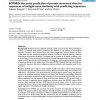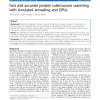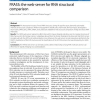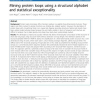COGSCI
2006
15 years 23 days ago
2006
Mechanical systems have structural organizations--parts, and their relations--and functional organizations--temporal, dynamic, and causal processes--which can be explained using t...
99
Voted
BMCBI
2006
15 years 24 days ago
2006
Background: Benchmarking algorithms in structural bioinformatics often involves the construction of datasets of proteins with given sequence and structural properties. The SCOP da...
102
Voted
BMCBI
2008
15 years 26 days ago
2008
Background: Protein structure prediction methods provide accurate results when a homologous protein is predicted, while poorer predictions are obtained in the absence of homologou...
92
Voted
BMCBI
2008
15 years 26 days ago
2008
Background: Protein structural alignment provides a fundamental basis for deriving principles of functional and evolutionary relationships. It is routinely used for structural cla...
103
click to vote
BMCBI
2008
15 years 26 days ago
2008
Background: Protein structure analysis and comparison are major challenges in structural bioinformatics. Despite the existence of many tools and algorithms, very few of them have ...
BMCBI
2010
15 years 26 days ago
2010
Background: The rapid development of structural genomics has resulted in many "unknown function" proteins being deposited in Protein Data Bank (PDB), thus, the functiona...
96
Voted
BMCBI
2007
15 years 26 days ago
2007
Background: Structural genomics initiatives were established with the aim of solving protein structures on a large-scale. For many initiatives, such as the Protein Structure Initi...
103
Voted
BMCBI
2010
15 years 26 days ago
2010
Background: Searching a database of protein structures for matches to a query structure, or occurrences of a structural motif, is an important task in structural biology and bioin...
121
click to vote
BMCBI
2010
15 years 26 days ago
2010
Background: The impressive increase of novel RNA structures, during the past few years, demands automated methods for structure comparison. While many algorithms handle only small...
94
Voted
BMCBI
2010
15 years 26 days ago
2010
Background: Protein loops encompass 50% of protein residues in available three-dimensional structures. These regions are often involved in protein functions, e.g. binding site, ca...




